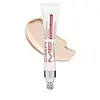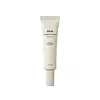What's inside
What's inside
 Key Ingredients
Key Ingredients

 Benefits
Benefits

 Concerns
Concerns

 Ingredients Side-by-side
Ingredients Side-by-side

Water
Skin ConditioningC12-15 Alkyl Benzoate
AntimicrobialHydrogenated Polyisobutene
EmollientGlycerin
HumectantAcrylates Copolymer
Pvp
Emulsion StabilisingSilica
AbrasiveCetyl Alcohol
EmollientGlyceryl Stearate
EmollientPEG-100 Stearate
PEG-40 Stearate
EmulsifyingDimethicone
EmollientHydrolyzed Sesame Protein Pg-Propyl Methylsilanediol
Skin ConditioningHydrolyzed Wheat Protein
Skin ConditioningSoy Protein Phthalate
EmollientPolyacrylamide
C13-14 Isoparaffin
EmollientLaureth-7
EmulsifyingSteareth-20
CleansingN-Hydroxysuccinimide
Skin ConditioningChrysin
Skin ConditioningPalmitoyl Tripeptide-1
Skin ConditioningPalmitoyl Tetrapeptide-7
Skin ConditioningButylene Glycol
HumectantAcetyl Tetrapeptide-5
HumectantPhenoxyethanol
PreservativeEthylhexylglycerin
Skin ConditioningCI 77891
Cosmetic ColorantCI 77491
Cosmetic ColorantWater, C12-15 Alkyl Benzoate, Hydrogenated Polyisobutene, Glycerin, Acrylates Copolymer, Pvp, Silica, Cetyl Alcohol, Glyceryl Stearate, PEG-100 Stearate, PEG-40 Stearate, Dimethicone, Hydrolyzed Sesame Protein Pg-Propyl Methylsilanediol, Hydrolyzed Wheat Protein, Soy Protein Phthalate, Polyacrylamide, C13-14 Isoparaffin, Laureth-7, Steareth-20, N-Hydroxysuccinimide, Chrysin, Palmitoyl Tripeptide-1, Palmitoyl Tetrapeptide-7, Butylene Glycol, Acetyl Tetrapeptide-5, Phenoxyethanol, Ethylhexylglycerin, CI 77891, CI 77491
Water
Skin ConditioningGlycerin
HumectantNiacinamide
SmoothingOctyldodecanol
EmollientCaprylyl Methicone
Skin ConditioningCaprylic/Capric Triglyceride
MaskingPentaerythrityl Tetraethylhexanoate
EmollientPentylene Glycol
Skin ConditioningPolyglyceryl-3 Methylglucose Distearate
EmulsifyingBehenyl Alcohol
EmollientMethylpropanediol
SolventPolymethylsilsesquioxane
1,2-Hexanediol
Skin ConditioningPanthenol
Skin ConditioningMacadamia Integrifolia Seed Oil
Skin ConditioningCetearyl Olivate
Hydroxyethyl Acrylate/Sodium Acryloyldimethyl Taurate Copolymer
Emulsion StabilisingSorbitan Olivate
EmulsifyingGlyceryl Stearate
EmollientMangifera Indica Seed Butter
Skin ConditioningPolyglyceryl-3 Distearate
EmulsifyingCetearyl Alcohol
EmollientAmmonium Acryloyldimethyltaurate/Vp Copolymer
Bis-Diglyceryl Polyacyladipate-2
EmollientStearyl Alcohol
EmollientCaprylyl Glycol
EmollientCetearyl Glucoside
EmulsifyingSqualane
EmollientEthylhexylglycerin
Skin ConditioningDipotassium Glycyrrhizate
HumectantXanthan Gum
EmulsifyingSorbitan Isostearate
EmulsifyingAnastatica Hierochuntica Extract
AstringentAdenosine
Skin ConditioningAllantoin
Skin ConditioningGlyceryl Stearate Citrate
EmollientTrisodium Ethylenediamine Disuccinate
Hydrogenated Lecithin
EmulsifyingLactobacillus Ferment
Skin ConditioningHippophae Rhamnoides Oil
EmollientCeramide NP
Skin ConditioningTocopherol
AntioxidantCollagen Extract
Skin ConditioningSodium Hyaluronate
HumectantBakuchiol
AntimicrobialCaffeine
Skin ConditioningTrehalose
HumectantDipropylene Glycol
HumectantMacadamia Ternifolia Seed Oil
EmollientButylene Glycol
HumectantPolyglyceryl-10 Laurate
Skin ConditioningPhosphatidylcholine
EmulsifyingAsiaticoside
AntioxidantPhytosphingosine
Skin ConditioningAsiatic Acid
Skin ConditioningGlycolipids
Skin ConditioningMadecassic Acid
Skin ConditioningPalmitoyl Tripeptide-5
Skin ConditioningSorbitol
HumectantBifida Ferment Filtrate
Skin ConditioningWater, Glycerin, Niacinamide, Octyldodecanol, Caprylyl Methicone, Caprylic/Capric Triglyceride, Pentaerythrityl Tetraethylhexanoate, Pentylene Glycol, Polyglyceryl-3 Methylglucose Distearate, Behenyl Alcohol, Methylpropanediol, Polymethylsilsesquioxane, 1,2-Hexanediol, Panthenol, Macadamia Integrifolia Seed Oil, Cetearyl Olivate, Hydroxyethyl Acrylate/Sodium Acryloyldimethyl Taurate Copolymer, Sorbitan Olivate, Glyceryl Stearate, Mangifera Indica Seed Butter, Polyglyceryl-3 Distearate, Cetearyl Alcohol, Ammonium Acryloyldimethyltaurate/Vp Copolymer, Bis-Diglyceryl Polyacyladipate-2, Stearyl Alcohol, Caprylyl Glycol, Cetearyl Glucoside, Squalane, Ethylhexylglycerin, Dipotassium Glycyrrhizate, Xanthan Gum, Sorbitan Isostearate, Anastatica Hierochuntica Extract, Adenosine, Allantoin, Glyceryl Stearate Citrate, Trisodium Ethylenediamine Disuccinate, Hydrogenated Lecithin, Lactobacillus Ferment, Hippophae Rhamnoides Oil, Ceramide NP, Tocopherol, Collagen Extract, Sodium Hyaluronate, Bakuchiol, Caffeine, Trehalose, Dipropylene Glycol, Macadamia Ternifolia Seed Oil, Butylene Glycol, Polyglyceryl-10 Laurate, Phosphatidylcholine, Asiaticoside, Phytosphingosine, Asiatic Acid, Glycolipids, Madecassic Acid, Palmitoyl Tripeptide-5, Sorbitol, Bifida Ferment Filtrate
 Reviews
Reviews

Ingredients Explained
These ingredients are found in both products.
Ingredients higher up in an ingredient list are typically present in a larger amount.
Butylene Glycol (or BG) is used within cosmetic products for a few different reasons:
Overall, Butylene Glycol is a safe and well-rounded ingredient that works well with other ingredients.
Though this ingredient works well with most skin types, some people with sensitive skin may experience a reaction such as allergic rashes, closed comedones, or itchiness.
Learn more about Butylene GlycolEthylhexylglycerin (we can't pronounce this either) is commonly used as a preservative and skin softener. It is derived from glyceryl.
You might see Ethylhexylglycerin often paired with other preservatives such as phenoxyethanol. Ethylhexylglycerin has been found to increase the effectiveness of these other preservatives.
Glycerin is already naturally found in your skin. It helps moisturize and protect your skin.
A study from 2016 found glycerin to be more effective as a humectant than AHAs and hyaluronic acid.
As a humectant, it helps the skin stay hydrated by pulling moisture to your skin. The low molecular weight of glycerin allows it to pull moisture into the deeper layers of your skin.
Hydrated skin improves your skin barrier; Your skin barrier helps protect against irritants and bacteria.
Glycerin has also been found to have antimicrobial and antiviral properties. Due to these properties, glycerin is often used in wound and burn treatments.
In cosmetics, glycerin is usually derived from plants such as soybean or palm. However, it can also be sourced from animals, such as tallow or animal fat.
This ingredient is organic, colorless, odorless, and non-toxic.
Glycerin is the name for this ingredient in American English. British English uses Glycerol/Glycerine.
Learn more about GlycerinGlyceryl Stearate is a mix of glycerin and stearic acid.
It is used to stabilize the mixing of water and oil ingredients. By preventing these ingredients from separating, it can help elongate shelf life. It can also help thicken the product's texture.
As an emollient, it helps soften skin and supports barrier-replenishing ingredients.
In cosmetics, Glyceryl Stearate is often made from vegetable oils or synthetically produced.
This ingredient may not be fungal-acne safe
Fun fact: The human body also creates Glyceryl Stearate naturally.
Learn more about Glyceryl StearateWater. It's the most common cosmetic ingredient of all. You'll usually see it at the top of ingredient lists, meaning that it makes up the largest part of the product.
So why is it so popular? Water most often acts as a solvent - this means that it helps dissolve other ingredients into the formulation.
You'll also recognize water as that liquid we all need to stay alive. If you see this, drink a glass of water. Stay hydrated!
Learn more about Water